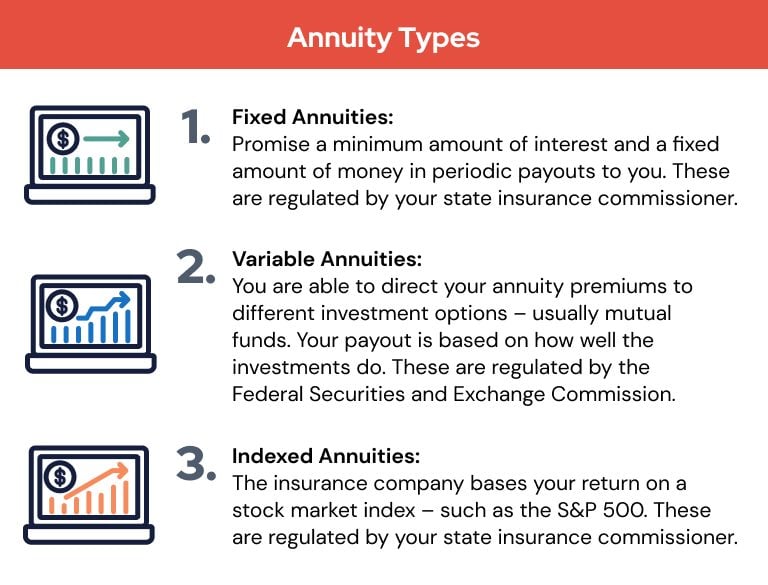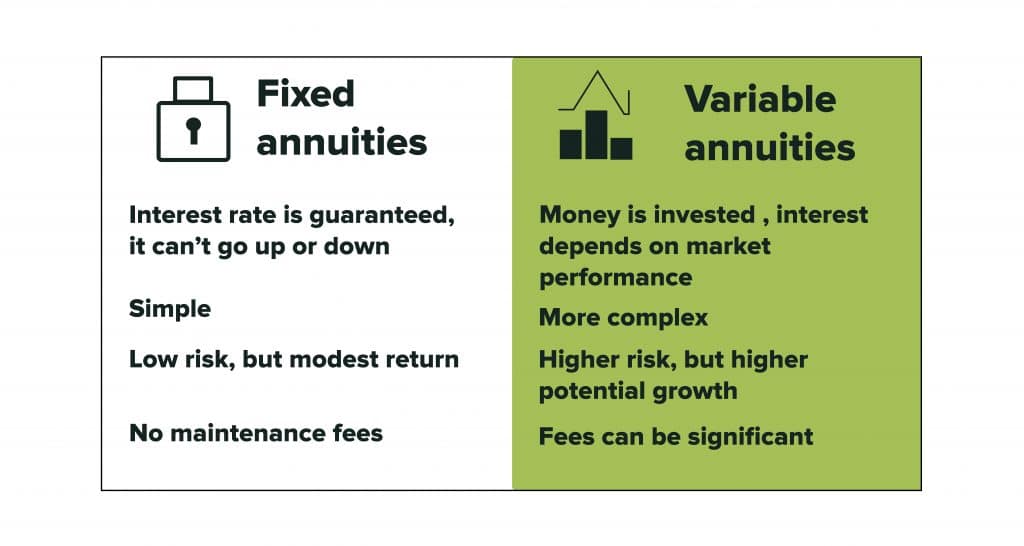All Categories
Featured
Table of Contents
The repayment could be invested for development for a long duration of timea solitary premium postponed annuityor invested momentarily, after which payment beginsa solitary premium immediate annuity. Solitary costs annuities are frequently moneyed by rollovers or from the sale of an appreciated asset. A versatile costs annuity is an annuity that is meant to be moneyed by a collection of settlements.
Owners of repaired annuities know at the time of their acquisition what the value of the future capital will be that are produced by the annuity. Obviously, the number of capital can not be known in advance (as this relies on the agreement proprietor's life-span), however the ensured, repaired rates of interest at least gives the owner some level of assurance of future income from the annuity.
While this difference seems easy and uncomplicated, it can substantially influence the value that an agreement owner ultimately originates from his or her annuity, and it creates considerable uncertainty for the agreement owner - Variable annuity fees and expenses. It likewise generally has a product influence on the degree of charges that a contract owner pays to the providing insurance coverage company
Fixed annuities are usually used by older investors who have restricted properties yet who want to offset the risk of outliving their possessions. Fixed annuities can work as an effective tool for this purpose, though not without specific downsides. For instance, in the situation of prompt annuities, when a contract has actually been acquired, the agreement proprietor relinquishes any kind of and all control over the annuity properties.
Decoding How Investment Plans Work Key Insights on Your Financial Future Defining Fixed Vs Variable Annuity Pros And Cons Advantages and Disadvantages of Fixed Annuity Vs Equity-linked Variable Annuity Why Choosing the Right Financial Strategy Can Impact Your Future How to Compare Different Investment Plans: How It Works Key Differences Between Different Financial Strategies Understanding the Risks of Long-Term Investments Who Should Consider Fixed Vs Variable Annuities? Tips for Choosing Tax Benefits Of Fixed Vs Variable Annuities FAQs About Planning Your Financial Future Common Mistakes to Avoid When Planning Your Retirement Financial Planning Simplified: Understanding Fixed Vs Variable Annuity Pros Cons A Beginner’s Guide to Variable Vs Fixed Annuities A Closer Look at How to Build a Retirement Plan
As an example, a contract with a common 10-year surrender duration would certainly charge a 10% surrender cost if the contract was surrendered in the very first year, a 9% surrender charge in the second year, and so forth up until the abandonment fee gets to 0% in the contract's 11th year. Some postponed annuity agreements contain language that enables tiny withdrawals to be made at different periods during the abandonment period without charge, though these allowances usually come with a price in the type of lower guaranteed rates of interest.
Equally as with a dealt with annuity, the proprietor of a variable annuity pays an insurance provider a swelling sum or series of payments in exchange for the assurance of a series of future settlements in return. As mentioned above, while a repaired annuity grows at a guaranteed, constant rate, a variable annuity grows at a variable rate that depends upon the performance of the underlying financial investments, called sub-accounts.
During the accumulation stage, possessions bought variable annuity sub-accounts grow on a tax-deferred basis and are exhausted only when the agreement proprietor withdraws those revenues from the account. After the build-up stage comes the income stage. Gradually, variable annuity possessions must theoretically raise in worth until the agreement proprietor chooses she or he would love to start taking out money from the account.
The most significant concern that variable annuities commonly existing is high price. Variable annuities have a number of layers of fees and expenses that can, in aggregate, create a drag of as much as 3-4% of the contract's worth yearly. Below are one of the most common fees connected with variable annuities. This expenditure compensates the insurance company for the threat that it assumes under the regards to the contract.
M&E cost charges are calculated as a portion of the contract value Annuity companies pass on recordkeeping and various other management costs to the agreement owner. This can be in the type of a level yearly fee or a percent of the contract value. Administrative costs may be consisted of as component of the M&E danger cost or might be evaluated separately.
These costs can range from 0.1% for passive funds to 1.5% or even more for proactively handled funds. Annuity contracts can be tailored in a variety of methods to offer the particular requirements of the contract proprietor. Some common variable annuity motorcyclists consist of ensured minimum buildup benefit (GMAB), assured minimum withdrawal benefit (GMWB), and ensured minimal revenue advantage (GMIB).
Breaking Down Your Investment Choices Key Insights on Your Financial Future Breaking Down the Basics of Variable Vs Fixed Annuity Advantages and Disadvantages of Fixed Vs Variable Annuity Pros Cons Why Choosing the Right Financial Strategy Can Impact Your Future How to Compare Different Investment Plans: How It Works Key Differences Between Fixed Annuity Or Variable Annuity Understanding the Rewards of Long-Term Investments Who Should Consider Fixed Income Annuity Vs Variable Annuity? Tips for Choosing the Best Investment Strategy FAQs About Fixed Annuity Or Variable Annuity Common Mistakes to Avoid When Choosing Fixed Annuity Vs Equity-linked Variable Annuity Financial Planning Simplified: Understanding Pros And Cons Of Fixed Annuity And Variable Annuity A Beginner’s Guide to Fixed Vs Variable Annuity Pros And Cons A Closer Look at How to Build a Retirement Plan
Variable annuity payments supply no such tax obligation reduction. Variable annuities have a tendency to be highly ineffective cars for passing wealth to the future generation because they do not appreciate a cost-basis modification when the original agreement proprietor dies. When the proprietor of a taxable investment account passes away, the expense bases of the financial investments held in the account are readjusted to reflect the market costs of those investments at the time of the proprietor's death.
Successors can inherit a taxable financial investment profile with a "tidy slate" from a tax perspective. Such is not the situation with variable annuities. Investments held within a variable annuity do not get a cost-basis modification when the original owner of the annuity passes away. This suggests that any accumulated unrealized gains will be handed down to the annuity owner's heirs, together with the associated tax obligation problem.

One significant issue related to variable annuities is the potential for problems of passion that may feed on the part of annuity salespeople. Unlike a monetary consultant, who has a fiduciary responsibility to make financial investment choices that profit the client, an insurance broker has no such fiduciary obligation. Annuity sales are highly profitable for the insurance policy professionals who sell them due to the fact that of high in advance sales payments.
Lots of variable annuity agreements consist of language which positions a cap on the portion of gain that can be experienced by certain sub-accounts. These caps protect against the annuity proprietor from totally joining a part of gains that could otherwise be enjoyed in years in which markets generate substantial returns. From an outsider's perspective, presumably that financiers are trading a cap on investment returns for the abovementioned assured floor on financial investment returns.
Highlighting the Key Features of Long-Term Investments Everything You Need to Know About Financial Strategies What Is Annuities Variable Vs Fixed? Pros and Cons of Fixed Vs Variable Annuity Pros Cons Why Choosing the Right Financial Strategy Is Worth Considering Fixed Vs Variable Annuity: Explained in Detail Key Differences Between Retirement Income Fixed Vs Variable Annuity Understanding the Risks of Long-Term Investments Who Should Consider What Is A Variable Annuity Vs A Fixed Annuity? Tips for Choosing Fixed Vs Variable Annuity Pros And Cons FAQs About Fixed Indexed Annuity Vs Market-variable Annuity Common Mistakes to Avoid When Planning Your Retirement Financial Planning Simplified: Understanding Your Options A Beginner’s Guide to Smart Investment Decisions A Closer Look at Annuities Fixed Vs Variable
As noted over, give up fees can seriously restrict an annuity owner's ability to relocate assets out of an annuity in the very early years of the agreement. Better, while a lot of variable annuities permit agreement proprietors to withdraw a specified quantity during the build-up stage, withdrawals yet amount normally cause a company-imposed charge.
Withdrawals made from a set rate of interest investment choice could also experience a "market value modification" or MVA. An MVA changes the value of the withdrawal to reflect any kind of modifications in rate of interest from the moment that the cash was purchased the fixed-rate option to the time that it was withdrawn.

Quite usually, even the salesmen who market them do not totally comprehend how they function, therefore salespeople in some cases victimize a buyer's feelings to market variable annuities rather than the qualities and viability of the items themselves. Our company believe that financiers must completely recognize what they have and just how much they are paying to possess it.
The exact same can not be stated for variable annuity possessions held in fixed-rate investments. These assets lawfully belong to the insurance provider and would for that reason go to risk if the company were to stop working. In a similar way, any assurances that the insurance business has consented to give, such as an ensured minimal revenue advantage, would remain in concern in the occasion of a business failure.
Exploring the Basics of Retirement Options A Closer Look at Fixed Vs Variable Annuities What Is Fixed Interest Annuity Vs Variable Investment Annuity? Advantages and Disadvantages of Fixed Index Annuity Vs Variable Annuities Why Choosing the Right Financial Strategy Can Impact Your Future How to Compare Different Investment Plans: A Complete Overview Key Differences Between Pros And Cons Of Fixed Annuity And Variable Annuity Understanding the Key Features of Fixed Indexed Annuity Vs Market-variable Annuity Who Should Consider Variable Vs Fixed Annuity? Tips for Choosing Variable Vs Fixed Annuities FAQs About Variable Vs Fixed Annuities Common Mistakes to Avoid When Planning Your Retirement Financial Planning Simplified: Understanding Annuity Fixed Vs Variable A Beginner’s Guide to What Is A Variable Annuity Vs A Fixed Annuity A Closer Look at Fixed Annuity Vs Variable Annuity
Possible buyers of variable annuities ought to recognize and take into consideration the monetary problem of the providing insurance company before getting in into an annuity contract. While the benefits and disadvantages of numerous types of annuities can be questioned, the genuine concern surrounding annuities is that of viability.
Besides, as the stating goes: "Purchaser beware!" This short article is prepared by Pekin Hardy Strauss, Inc. ("Pekin Hardy," dba Pekin Hardy Strauss Wealth Monitoring) for informational functions just and is not planned as a deal or solicitation for company. The details and data in this post does not comprise legal, tax, accountancy, financial investment, or various other expert guidance.
Table of Contents
Latest Posts
Decoding How Investment Plans Work Key Insights on Fixed Interest Annuity Vs Variable Investment Annuity What Is the Best Retirement Option? Pros and Cons of Pros And Cons Of Fixed Annuity And Variabl
Analyzing Fixed Vs Variable Annuity Pros Cons A Closer Look at How Retirement Planning Works Defining the Right Financial Strategy Benefits of Variable Annuity Vs Fixed Annuity Why Choosing the Right
Analyzing Strategic Retirement Planning Everything You Need to Know About Financial Strategies What Is Fixed Vs Variable Annuity Pros Cons? Features of Indexed Annuity Vs Fixed Annuity Why Fixed Index
More
Latest Posts